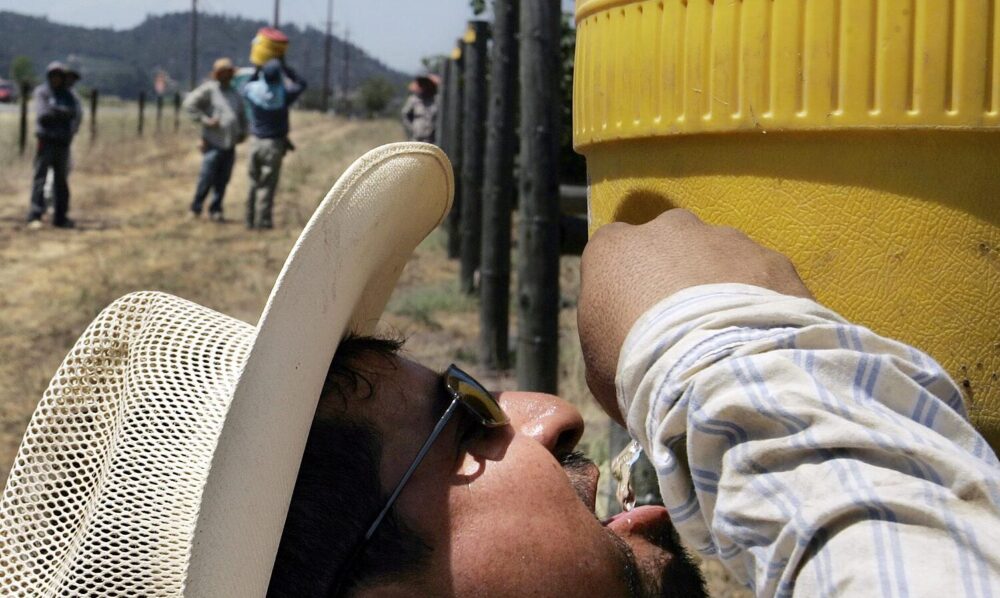Climate scientists at the Union of Concerned Scientists (UCS) have dubbed the six-month stretch from May through October “Danger Season” because of the confluence of extreme weather—record heat, raging wildfires, severe storms, and flooding—that is putting people at risk around the world. In 2022 alone, cities in Arizona, California, Nevada, Texas, and Utah recorded temperatures of 105°F on multiple days and often over long stretches. The heat index (what the temperature feels like to the human body when relative humidity is coupled with air temperature) for this temperature is considered dangerous by the National Weather Service.
Danger Season is an especially perilous time for outdoor workers like farmworkers. On hot days, while many of us have the option to retreat indoors, switch on our air conditioning units or fans, and sip cold beverages, farmworkers all over the country do not. California alone is estimated to have about 830,000 farmworkers. If you add in Arizona, Nevada, Texas, and Utah, more than a million farmworkers have been exposed to dangerously high heat this summer.
Heat: the silent killer
This Danger Season has been characterized by record-breaking temperatures all over the United States. Can you imagine being outdoors for 8 to 10 hours every day when the thermometer reads 115°F? As heat waves blanketed the nation this Danger Season, 2.4 million farmworkers continued to work outside. Long hours of work in the sun can result in fatigue, cramps, dehydration, heat stroke, and other health issues.
Data have shown that farmworkers die of heat-related causes at a rate 20 times greater than other professions. In April 2022, a farmworker picking strawberries in Florida passed away due to heat, and according to news reports, it was just his second day on the job. Between 1992 and 2017, at least 815 farmworker deaths have been attributed to heat. This number is likely undercounted and misattributed because heat-induced illnesses and conditions are often not traced correctly to their source.
Poor working conditions make farmworkers extra vulnerable to heat exposure and illness. Often, farmworkers are paid based on how many buckets or bags of that day’s crop they pick, known as the piece rate, and do not take breaks in fear of losing income and retribution from farm managers. Thousands of farms all over the country lack proper heat-illness prevention plans, pushing farmworkers to work continuously without water breaks or rest even when conditions are dangerous. In the absence of a federal heat standard, hundreds of thousands of farmworkers remain without protection.
Danger Season amps up pesticide risks
As temperatures rise, so do the dangers associated with pesticides. Personal protection equipment mandated by the Environmental Protection Agency—including long sleeves and multiple layers—are often uncomfortable to wear in warmer weather and can cause overheating. Heat vaporizes pesticides faster, and these harmful vapors can drift, increasing exposure for farmworkers and families living nearby.
About 5.1 billion pounds of pesticides are applied to crops in the United States every year, but there are often gaps in the science behind pesticide risk assessments, tipping the balance in favor of industry-backed science, ignoring chronic risks to farmworkers and secondary exposure to farmworkers’ families and communities living around agricultural fields. In addition, pesticide labels are often printed in English only; farmworker groups around the country have been advocating for labels in other languages to increase accessibility to vital health and safety information.
Extreme weather brings new threats
Wildfire smoke containing a variety of air pollutants and particulate matter, especially in the West, has increased the chances that farmworkers will experience adverse health hazards such as asthma and respiratory disease. In drought-stricken western states, many farmworker communities are also struggling with access to clean drinking water. Lack of access to proper health care, poor housing conditions, low wages, and communication barriers all cumulatively prevent farmworkers from receiving medical care when required and can exacerbate the harms of heat, pesticides, and smoke.
Farmworkers deserve to work in dignity and safety, and the laws designed to protect them do not fulfill those requirements.
Farmworkers are the foundation of our food and farming industry but have long been subject to inequitable and unjust practices that systematically exclude them from protection. According to recent surveys, about 68 percent of farmworkers are immigrants, and approximately 36 percent lack authorized work status under current US laws. In a country that relies on farmworker labor to feed us, we must ensure that we design laws that adequately protect them.
How can we protect our farmworkers?
The dangers of extreme heat, wildfire smoke, drought, and other climate-related impacts are almost certain to increase in frequency in the coming years. Data on farmworker health and workplace injuries are hard to access, with no concrete reporting structure, and often need to be pieced together from sparse sources that are hard to find. Increased investment in research on the risks and threats to farmworker health can be used to improve access to information on the effects on agrochemicals and heat on farmworkers, and effectively support a national heat standard for indoor and outdoor workers.
Policy changes such as making the federal regulation of pesticides and other agrochemicals more transparent, immigration policy reform, stronger enforcement of occupational health and safety standards, expanded access to health care and benefits, and the inclusion of agricultural workers in wage laws could protect the health of the people who are fundamental to the long-term sustainability and stability of our food system.
Even though this year’s Danger Season has come to an end, there is no respite for farmworkers. The West continues to be in the grip of a severe drought and projections show dry conditions will persist. On farmland all over the country, millions of gallons of pesticides will continue to be sprayed. Farmworkers will continue to work in excruciating conditions for minimum wage. The intensity and frequency of heat waves will continue to increase—so how do we protect farmworkers in the face of this climate emergency? If governments or regulatory agencies don’t protect farmworkers, who will?

